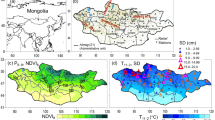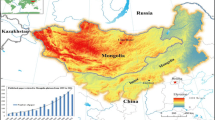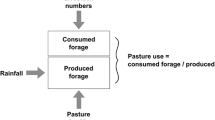Abstract
Mongolian pastoral husbandry is subject to various climate hazards such as dzud (Mongolian for “severe winter conditions”). Dzud in the 2009/2010 winter affected 80.9% of the country and killed more than 10 million livestock (23.4% of the total). To understand the natural and man-made mechanisms of this dzud, we examined the contributions of dzud-causing factors such as climate hazards (cold temperatures and heavy snow) and winter–spring livestock grazing (measured as overgrazing rate), which created a distinct regional pattern of high livestock mortality using a regression tree method. The regression tree model accounted for 58% of the total spatial variation of the mortality and identified various types of dzud in each region. Results showed that during the 2009/2010 winter, almost all of Mongolia experienced extreme cold temperatures, with abnormally large amounts of snow. In addition, more than half of the territory was overgrazed because of the lower pasture biomass resulting from summer drought and livestock overpopulation. At the regional scale, high livestock mortalities occurred in moderately to heavily overgrazed regions in south-central and western Mongolia, resulting from the combination of these factors. Conversely, areas with lower livestock mortalities (or non-dzud) coincided with sufficient pasture capacity in the north and east, even under extreme cold and snow. This indicates the importance of controlling the number of livestock to below the pasture carrying capacity regardless of an inter-annually varying climate. Moreover, we identified critical thresholds of each factor across which serious disasters occurred. These thresholds are practically useful for future livestock management of pasture land.








Similar content being viewed by others
Change history
16 September 2020
The article contains an error in its Data section. The author group would like all to note and acknowledge:
References
Addison J, Brown C (2014) A multi-scaled analysis of the effect of climate, commodity prices and risk on the livelihoods of Mongolian pastoralists. J Arid Environ 109:54–64
Amatulli G, Rodrigues MJ, Trombetti M, Lovreglio R (2006) Assessing long-term fire risk at local scale by means of decision tree technique. J Geophys Res 111:G04S05. doi:10.1029/2005JG000133
Badarch D, Zilinskas RA, Balint PJ (2003) Mongolia today: science, culture, environment and development. Routledge, London. ISBN 0-7007-1598-3
Batjargal Z, Oyun R, Togtokh N, Sangidansranjav S (2002) Lessons learnt from the dzud 1999–2000 fundamental issues affecting sustainability of the Mongolian steppe. IISCN, Ulaanbataar, pp 73–98
Bazargur D (2013) The science of ecological geography. Institute of Geography, Mongolian Academy of Sciences, Ulaanbaatar (in Mongolian)
Begzsuren S, Ellis JE, Ojima DS, Coughenou MB, Chuluun T (2004) Livestock responses to drought and severe winter weather in the Gobi Three Beauty National Park, Mongolia. J Arid Environ 59:786–796
Benson C (2011) Dzud disaster financing and response in Mongolia. World Bank, Washington. https://openknowledge.worldbank.org/handle/10986/13065
Breiman L, Friedman JH, Olshen RA, Stone CI (1984) Classification and regression trees. Wadsworth, Belmont
Chogsom D (1964) Some aspects of dzud studies. Geographical aspects in Mongolia 2: Ulaanbaatar (in Mongolian)
Condon RW (1968) Estimation of grazing capacity on arid grazing lands. In: Stewart GA (ed) Land evaluation. Macmillan, Melbourne, pp 112–124
Condon RW, Newman JC, Cunningham GM (1969) Soil erosion and pasture degeneration in Central Australia: part III—the assessment of grazing capacity. J. Soil Conserv Serv NSW 25:25–50
Dagvadorj D (2010) Mongolia Second National Communication under the United Nations Framework Convention on Climate Change. Ministry of Nature, Environment and Tourism, and UNEP, Ulaanbaatar
Davaajamts C, Danzannyam B, Nyamsanjaa S (1968) Report on dzud investigation. Papers of Institute of Meteorology and Hydrology. Ulaanbaatar (in Mongolian)
De’ath G, Fabricius KE (2000) Classification and regression trees: a powerful yet simple technique for ecological data analysis. Ecology 81:3178–3192
Du Ch, Shinoda M, Tachiiri K, Nandintsetseg B, Komiyama H, Matsushita SH (2017) Mongolian herders’ vulnerability to dzud: a study of record livestock mortality levels during the severe 2009/2010 winter. Nat Hazards. doi:10.1007/s11069-017-2893-4
Erdenetsetseg B, Bayarbaatar L (2001) Methodology for estimation of pasture capacity (for official purpose). Institute of Meteorology and Hydrology, Ulaanbaatar (in Mongolian)
Erdenetsetseg B, Doljinsuren M, Nandintsetseg B (2015) Drought and 2009–2010 Dzud. In: Shinoda M, Nandintsetseg B (eds) Scientific report on climate change and hazards in Mongolia. Nagoya University, Nagoya. http://www.4d-disasters.jp/en
FAO (1988) Guidelines: land evaluation for extensive grazing. FAO Soil Bulletin, No. 58, Rome
Fernandez-Gimenez M, Batbuyan B, Batkhishig B (2011) Understanding resilience in Mongolian pastoral social-ecological systems: adapting to disaster before, during and after 2010 dzud-year 1 report. World Bank, Washington. https://openknowledge.worldbank.org/handle/10986/2199
Fernandez-Gimenez ME, Batkhishig B, Batbuyan B (2012) Cross-boundary and cross-level dynamics increase vulnerability to severe winter storms (dzud) in Mongolia. Glob Environ Change 22:836–851
Friis-Hansen E (1995) Seeds for African peasants. Peasants’ needs and agricultural research—the case of Zimbabwe, 1st edn. Uppsala, Nordiska Afrikainstitutet, p 105
Goulden CE, Nandintsetseg B, Ariuntsetseg L (2011) The geology, climatology and ecology of Mongolia. In: Sabloff PLW (ed) Mapping Mongolia: situating Mongolia in the world from geologic time to the present. University of Pennsylvania Press, University of Pennsylvania Museum of Archaeology and Anthropology, Philadelphia
Goulden CE, Mead J, Horwitz R, Goulden M, Nandintsetseg B, McCormick S, Boldgive B (2016) Interviews of Mongolian herders and high resolution precipitation data reveal an increase in short heavy rains and thunderstorm activity in semi-arid Mongolia. Clim Change 136:281–295
Government Resolution (2000) Measures to be taken to prevent for drought: dzud and weather disasters. www.legalinfo.mn
Hamilton WT (2003) Drought: managing for and during the bad years. In: Forgason CA, Bryant FC, Genho PC (eds) Ranch management; integrating cattle, wildlife, and range. King Ranch, Kingsville, pp 133–152
Henrard S, Speybroeck N, Hermans C (2015) Classification and regression tree analysis vs. multivariable linear and logistic regression methods as statistical tools for studying haemophilia. Haemophilia 21:715–722
Hilker T, Natsagdorj E, Waring RH, Lyapustin A, Wang Y (2015) Satellite observed widespread decline in Mongolian grasslands largely due to overgrazing. Glob Change Biol 20(2):418–428
Holechek JL, Pieper RD, Herbel CH (1995) Range management principles and practices, 2nd edn. Prentice Hall, Englewood Cliffs, pp 197–204
Iijima Y, Hori ME (2016) Cold air formation and advection over Eurasia during “Dzud” cold disaster winters in Mongolia. Nat Hazards. doi:10.1007/s11069-016-2683-4
IPCC (2012) Managing the risks of extreme events and disasters to advance climate change adaptation. In: Field CB, Barros V, Stocker TF et al (eds) A special report of working groups I and II of the intergovernmental panel on climate change. Cambridge University Press, Cambridge, p 582
IRIMHE (Information and Research Institute of Meteorology, Hydrology and Environment) (2009) Winter weather outlook booklet, Ulaanbaatar
Ito A, Hayashi M, Hamasaki T, Ebisu S (2011) Risk assessment of dental caries by using classification and regression trees. J Dent 39:457–463
Ji Z, Li N, Xie W, Zhou Y (2013) Comprehensive assessment of flood risk using the classification and regression tree method. Stoch Environ Res Risk Assess 27:1815. doi:10.1007/s00477-013-0716-z
Johnston PW, McKeon GM, Day KA (1996) Objective “safe” grazing capacities for southwest Queensland Australia: development of a model for individual properties. Rangel J 18(2):244–258
Keyantash J, Dracup J (2002) The quantification of drought: an evaluation of drought indices Bull. Am. Meteorol. Soc. 83:1167–1180
Kioko J, Kiringe JW, Seno SO (2012) Impacts of livestock grazing on a savanna grassland in Kenya. J Arid Land 4(1):29–35
Lee R (2008) Pasture, rangeland and grazing management. A publication of ATTRA-National Sustainable Agriculture Information Service. www.attra.ncat.org
Lkhagvadorj D, Hauck M, Dulamsuren Ch, Tsogtbaatar J (2013) Pastoral nomadism in the forest-steppe of the Mongolian Altai under a changing economy and a warming climate. J Arid Environ 88:82–89
McKeon GM, Stone GS, Syktus I et al (2009) Climate change impacts on northern Australian rangeland livestock carrying capacity: a review of issues. Rangel J 31:1–29
Mearns R (2004) Sustaining livelihoods on Mongolia’s pastoral commons: insights from a participatory poverty assessment. Dev Change 35(1):107–139
Middleton N, Rueff H, Sternberg T, Batbuyan B, Thomas D (2014) Explaining spatial variations in climate hazard impacts in western Mongolia. Landsc Ecol. doi:10.1007/s10980-014-0091-2
Milner-Gulland EJ, Mace R (1998) Conservation of biological resources. Blackwell Science Ltd, Oxford
Morinaga Y, Tian S, Shinoda M (2003) Winter snow anomaly and atmospheric circulation in Mongolia. Int J Climatol 23:1627–1636
Namkhai A, Mijiddorj R (1986) Drought frequency and unfavorable winter condition in Mongolia. Proc Inst Meteorol 11:118–131
Nandintsetseg B, Shinoda M (2011) Seasonal change of soil moisture and its climatology and modeling in Mongolia. Int J Climatol 31:1143–1152
Nandintsetseg B, Shinoda M (2013) Assessment of drought frequency, duration, and severity and its impact on pasture production in Mongolia. Nat Hazards 66:995–1008
Nandintsetseg B, Shinoda M (2015) Land surface memory effects on dust emission in a Mongolian temperate grassland. J Geophys Res Biogeosci 120:414–427
Nandintsetseg B, Greene JS, Goulden CE (2007) Trends in extreme daily precipitation and temperature near Lake Hövsgöl, Mongolia. Int J Climatol 27:341–347
Natsagdorj L (2003) Climate change. In: Batima P (ed) Climate change: pasture and animal husbandry. Institute of Meteorology and Hydrology of Mongolia, Ulaanbaatar, pp 13–14
Natsagdorj L (2014) Mongolia second assessment report on climate change. MARCC-2014, p 130
Natsagdorj L, Dulamsuren J (2001) Some aspects of assessment of the dzud phenomena. Pap Meteorol Hydrol 23:3–18
NSO (National Statistical Office) (2016) Livestock mortality. Ulaanbaatar. http://1212.mn/contents/stats/contents_stat_fld_tree_html.jsp
Okayasu T, Muto M, Jamsran U, Takeuchi K (2007) Spatially heterogeneous impacts on rangeland after social system change in Mongolia. Land Degrad Develop 18:555–566
Otani S, Mu H, Onishi K, Kurozawa Y, Shinoda M (2014) Risk prediction of the effects of severe winter disasters (dzud) on nomadic health and society in Mongolia with regard to loss of livestock. Int J Epidemiol 44:i178
Rao MP, Davi NK, D’Arrigo RD et al (2015) Dzuds, droughts, and livestock mortality in Mongolia. Environ Res Let 10(7):074012. doi:10.1088/1748-9326/10/7/074012
Rovlias A, Kotsou S (2004) Classification and regression tree for prediction of outcome after severe head injury using simple clinical and laboratory variables. J Neurotrauma 21:886–893
Save the Children (2010) Report on the 2009–2010 dzud disaster impact on schools, kindergartens, children and teachers in Mongolia, Ulaanbaatar
Schilling C, Mortimer D, Dalziel K et al (2016) Using classification and regression trees (CART) to identify prescribing thresholds for cardiovascular disease. Pharmacoeconomics 34:195. doi:10.1007/s40273-015-0342-3
Shinoda M (2012) Land: proactive management of drought and its derived disasters. In: Shaw R, Phong T (eds) Environment disaster linkages, community, environment and disaster risk management 9. Emerald Publishers, Bingley, pp 61–78
Shinoda M (2017) Evolving a multi-hazard focused approach for arid Eurasia. In: Sternberg T (ed) Climate hazard crises in Asian societies and environments. Routledge, Oxon
Shinoda M, Morinaga Y (2005) Developing a combined drought–dzud early warning system in Mongolia. Geogr Rev Jpn 78(13):928–950
Singh R, Wagener T, Crane R, Mann ME, Ning L (2014) A vulnerability driven approach to identify adverse climate and land use change combinations for critical hydrologic indicator thresholds: application to a watershed in Pennsylvania, USA. Water Resour Res 50:3409–3427
Sternberg T (2010) Unravelling Mongolia’s extreme winter disaster of 2010. Nomadic Peoples 14:72–86
Sternberg T (2017) Investigating the presumed causal links between drought and dzud in Mongolia. Nat Hazards. doi:10.1007/s11069-017-2848-9
Sternberg T, Batbuyan B (2013) Integrating the Hyogo Framework into Mongolia’s disaster risk reduction (DRR) policy and management International. J Disaster Risk Reduct 5:1–9
Suttie JM (2005) Grazing management in Mongolia. In: Suttie JM, Reynolds SJ, Batelo C (eds) Grasslands of the world, plant production and protection series 34. FAO-UN, Rome, pp 265–304
Tachiiri K, Shinoda M, Klinkenberg B, Morinaga Y (2008) Assessing Mongolian snow disaster risk using livestock and satellite data. J Arid Environ 72:2251–2263
Thapa GB, Paudel GS (2000) Evaluation of the livestock carrying capacity of land resources in the hills of Nepal based on total digestive nutrient analysis. Agric Ecosyst Environ 78(3):223–235
Tserendash S, Erdenebaatar B (1993) Performance and management of natural pasture in Mongolia. Nomadic Peoples 33:9–15
Tuvaansuren G (1986) Results of zoo-meteorological observation in Mongolia. Pap Meteorol Hydrol 11:132–145 (in Russian)
Tuvaansuren G, Sangidansranjav S, Danzannyam B (1996) Weather conditions for pastoral husbandry. Institute of Meteorology and Hydrology, Orchlon Printing, Ulaanbaatar
UNDP, NAMHEM (2000) Lessons learnt from the dzud 1999–2000. NAMHEM and JEMR Consulting Company, UNDP Project MON/00/302
UNDP, NEMA (2010) Dzud national report 2009–2010, Project ID: 00074253. UNDP-NEMA, Ulaanbaatar
Vallentine JF (1990) Grazing management. Academic Press, San Diego, pp 302–308
Vayssieres MP, Plant RE, Allen-Diaz BH (2000) Classification trees: an alternative non-parametric approach for predicting species distributions. J Veg Sci 11:679–694
Wang C, Liu H, Lee SK (2010) The record-breaking cold temperatures during the winter of 2009/2010 in the Northern Hemisphere. Atmos Sci Lett 11:161–168
Wesche K, Ronnenberg K, Retzer V, Miehe G (2010) Effects of large herbivore exclusion on southern Mongolian desert steppes. Acta Oecol 36:234–241
Zhang J, Zhang L, Liu W et al (2014) Livestock-carrying capacity and overgrazing status of alpine grassland in the Three-River Headwaters region, China. J Geogr Sci 24:303. doi:10.1007/s11442-014-1089-z
Acknowledgements
The authors are deeply indebted to the Information and Research Institute of Meteorology, Hydrology and Environment of Mongolia, who provided the livestock grazing rate and meteorological data used in this study. This research was supported by Invitation Fellowship for Research in Japan (6016ZL6554) and Grant-in-Aid for Scientific Research (25220201) provided by the Japan Society for the Promotion of Science (JSPS).
Author information
Authors and Affiliations
Corresponding author
Rights and permissions
About this article
Cite this article
Nandintsetseg, B., Shinoda, M. & Erdenetsetseg, B. Contributions of multiple climate hazards and overgrazing to the 2009/2010 winter disaster in Mongolia. Nat Hazards 92 (Suppl 1), 109–126 (2018). https://doi.org/10.1007/s11069-017-2954-8
Received:
Accepted:
Published:
Issue Date:
DOI: https://doi.org/10.1007/s11069-017-2954-8




